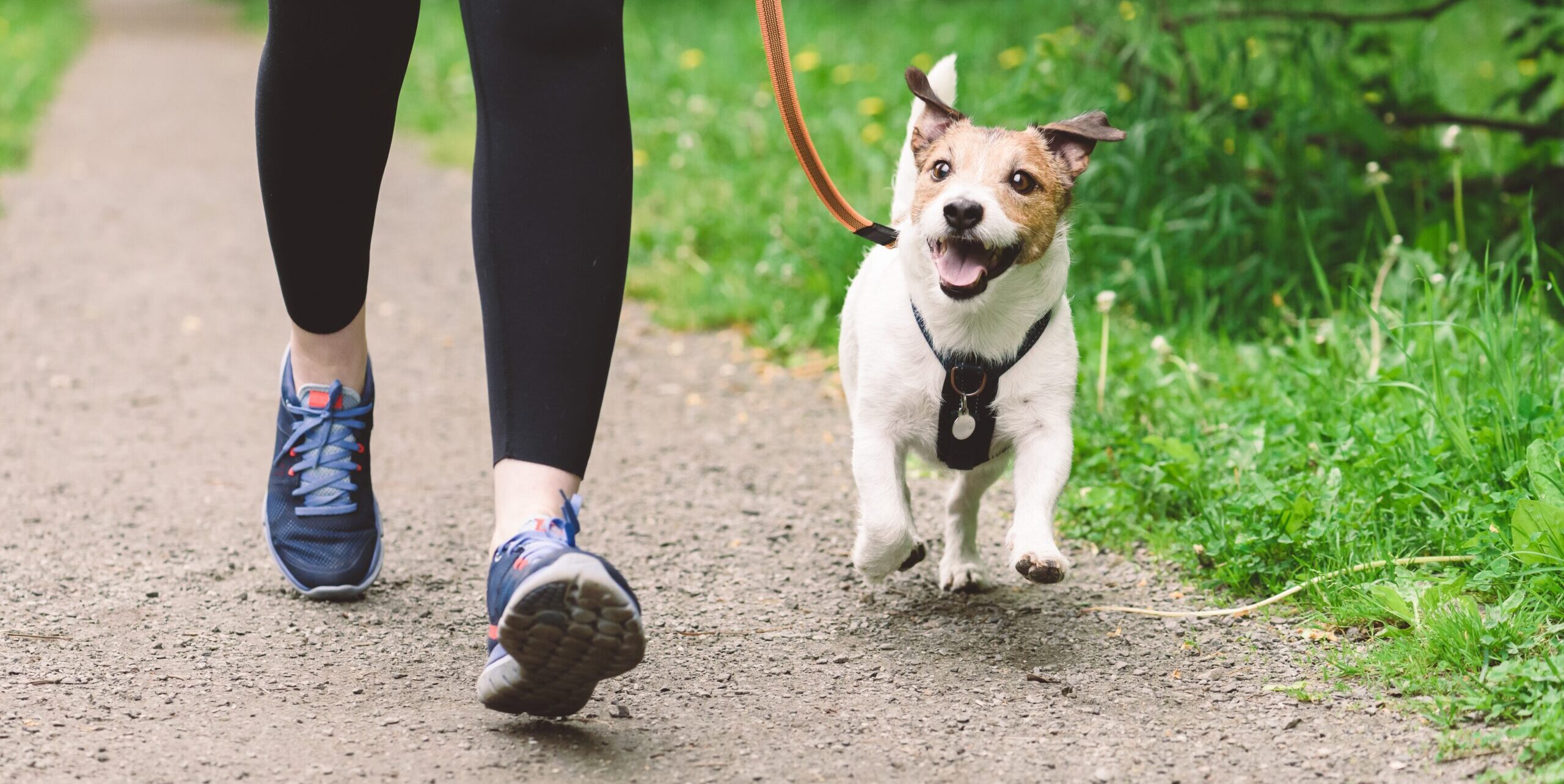Best Friends: 5 Ways to Safely Run with Your Dog!
When I come back from my teaching job, there’s nothing better than disappearing into the woods for a run. Actually, scratch that—there is one better thing. It’s disappearing into the woods for a run with my dog. Her unwavering excitement to go running no matter the weather helps me get out even when I’d rather stay in, and that wagging tail and hoppy-floppy ears are a recipe for happiness. In short, running with my dog is the definition of joy.
Do you, too, want to make your runs more exciting? Bring your furry friend along! It will be a special bonding experience. Your pup’s ever-present enthusiasm can motivate you to push yourself, run longer distances, and enjoy every moment.
Written & edited by Pavlína Marek
Having a dog as your running buddy will bring much joy and many benefits to the both of you.
- Natural Motivation: Dogs don’t make excuses or skip workouts—their excitement to exercise is contagious
- Enhanced Security: A running partner who also keeps an eye out for your safety
- Improved Mental Health: The combination of exercise and spending time with your pet lifts your spirits and reduces stress
- Stronger Bond: Doing things together strengthens the connection between you and your dog
- Built-in Training Partner: Sticking to a regular workout routine becomes easier when you have an enthusiastic companion waiting for you
While this all might sound pawsome, before you put on your running shoes and grab the leash, it’s important to know how to make these outings safe and enjoyable for your pup. Just like us, dogs need proper preparation and training to become good runners.
1. Assess Your Dog’s Fitness Level
Just like you, your dog needs to be well before they can embark on an adventure with you. Make sure your furry friend is ready for those running outings!
Breed-Specific Considerations
There are some dogs that will happily spend every day running and it still won’t be enough. On the other hand, there are also those who have limitations, often caused by breeding.
- Long-nosed (dolichocephalic) breeds (Retrievers, Huskies) are natural runners with excellent breathing capacity.
- Short-nosed (brachycephalic) breeds (Pugs, Boxers) have limited running ability due to breathing challenges. For some such dogs, running can be dangerous because of these limitations. They “often suffer from health problems including breathing issues (Newall, 2024).”
- Working breeds (German Shepherds, Border Collies) have high endurance and are built for distance.
- Toy breeds (Chihuahuas, Yorkies) are better suited for shorter runs brisk walks, or (let’s be honest) the sofa.
Age & Health Factors
- Puppies: Wait until growth plates close, about 12-18 months (Ushi, 2023)
- Senior dogs: Reduced exercise duration and intensity needed (Ushi, 2023)
- Weight: Extra pounds require more gradual conditioning and, in some cases, weight loss
- Joint health: Previous injuries need special attention, remember to warm up, cool down, and select appropriate running surface (Ennis, 2024)
Before you head out with your doggo, you should watch out for and assess if your pup partner has any difficulty with breathing during light exercise, is limping or favoring certain legs, or experiences excessive fatigue after short activities. If there were any recent surgeries or medical procedures, you should also wait until a full recovery is made.
A veterinary check-up is recommended before starting any running routine. Your vet can assess joint and bone health, check heart and respiratory function, screen for underlying health issues, and provide breed-specific exercise recommendations.
2. Start Slowly and Gradually Build Stamina
Just like you wouldn’t (or, rather shouldn’t) jump straight into running marathons, your pup needs time to build their endurance. A gradual exercise plan helps prevent injuries and keeps your furry friend excited about their new running adventures.
- Take 15-20 minute brisk walks 2-3 times per week
- Include short jogging intervals
- Extend walks to 20-30 minutes 3-4 times per week
- Alternate walking and jogging in roughly equal amounts
- You can now do 30+ minute running sessions 4 times per week
- Include walking intervals when necessary
Watch your dog’s body language during these sessions—a happy pup will have relaxed ears, regular breathing patterns, engaged attention, and a bounce in its step.
3. Warm Up, Cool Down, and Choose the Right Path
Just like humans need to stretch before hitting the track, your four-legged running buddy needs proper preparation, too! A warm-up routine helps prevent injuries and gets those muscles ready for action.
Warm-Up
Despite many runners forgoing their warm-up routines, try not to do the same when running with your dog.
- Let your pup sniff and explore for 5-10 minutes
- Play a game of fetch
- Walk at a brisk pace for several minutes
- Practice basic commands while walking to engage both mind and body
Selecting the Perfect Running Route
Your dog’s paws and joints deserve special consideration when choosing where to run. Natural surfaces provide the best cushioning.
✅ Opt for dirt trails, grassy paths, forest tracks, or sand (in moderation).
❌ Always avoid hot asphalt (can burn paw pads), concrete (too hard on joints), gravel (may hurt sensitive paws), and ice or snow (risks of frostbite).
Cool-Down
Toward the end of your run, help your furry friend calm down.
- Reduce speed to a gentle walk for the last 5-10 minutes
- At home, offer small sips of water and check paws for any signs of wear
4. Ensure Safety During Runs: Leash Manners, Hydration, and Overheating Awareness
Let’s unleash some essential safety tips to keep your four-legged running buddy safe and happy during your adventures!
Leash Selection & Control
A 4-6 foot non-retractable leash is your best friend for running sessions. This length gives your pup enough freedom to move naturally while keeping them safely under control. Avoid retractable or unnecessarily long leashes; they’re a recipe for tangled legs and unexpected pulls!
Train your dog to run on your left side, maintaining a loose “J” shape in the leash. This position helps prevent crossing paths and keeps both of you in sync.
You shouldn’t run with the lead clipped to your dog’s collar. Get a harness for your furry friend to avoid running on collar, which might cause injuries (Canter, 2023).
Hydration
Your furry friend needs regular water breaks during runs. Here’s how to keep them hydrated:
- Carry a collapsible water bowl
- Offer small sips every 15-20 minutes
- Try not to let them drink from standing water or puddles
Your dog also shouldn’t drink too much, which could cause them to throw up (Austin, 2024). Play it by ear; if you need to drink, your pup probably does, too.
Overheating Signs
Dogs can’t tell us when they’re too hot, but their bodies give clear signals (RSPCA):
- Excessive drooling
- Bright red tongue or gums
- Heavy panting that doesn’t subside
- Unsteady movement or disorientation
- Vomiting or diarrhea
5. Protect Their Paws and Be Attentive During Runs
Your pup’s paws need special attention during and after runs. After all, these precious pads are their direct connection to the ground. Always make sure that the surface is not too sharp or hot to run on. Unless you’re a barefoot runner, I recommend you do this simple test to see if the surface is suitable for your pup: place your palm on the running surface for 5 seconds. If it’s too hot for your hand, it’s too hot for their paws!
Happy paws, happy pup partner! Protect your dog’s paws before, during, and after each run.
- Apply dog-specific paw balm before runs
- Consider dog booties for extreme temperatures
- Run during cooler hours on hot days
- Stick to grass or dirt trails when possible
- Avoid salt-treated surfaces in winter
Your furry friend can’t speak up when something’s wrong; you need to watch for signs of discomfort:
- Sudden slowing or stopping
- Limping or favoring a paw
- Excessive licking of paws
- Looking back at you repeatedly
- Trying to move to softer surfaces
- Sitting or lying down unexpectedly
- Cracks or splits
- Redness or swelling
- Foreign objects
- Ice buildup in winter
- Signs of wear or roughness
Your dog can be the most loyal training partner you’ll ever have. It will always be ready to go for a run, no matter what. Follow these safety guidelines, pay attention to your dog’s needs, and you’ll establish a healthy routine that benefits both of you. A tired dog is a happy dog, and a happy dog makes for an even happier human. So put on those running shoes, grab the leash, and get ready for countless adventures together! 🐾


